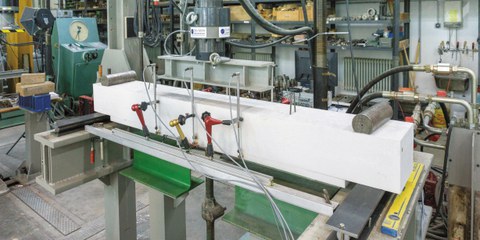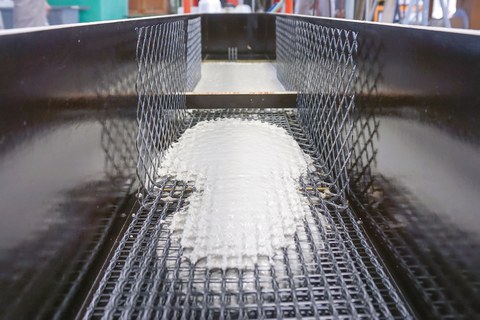A carbon-reinforced concrete forest
Table of contents
Project data
| Titel | Title Zulassungsversuche für Canopies aus Textilbeton für die Sächsische Aufbaubank (SAB) in Leipzig | Approval tests for carbon concrete Canopies for the Sächsische Aufbaubank (SAB) in Leipzig Auftraggeber | Client CarboCon GmbH, Dresden Zeitraum | Period 01.2017 – 03.2018 Leiter | Project Manager Prof. Dr.-Ing. Dr.-Ing. E.h. Manfred Curbach (Institut für Massivbau, TU Dresden), Bearbeiter | Contributors Dipl.-Ing. Robert Schneider, Otto-Mohr-Laboratorium |
Report from the annual report 2017
For the new administrative building of the Sächsische Aufbaubank (SAB) in Leipzig, it was desired to include new regional research products, to highlight the character of the development bank. The composite material will be used in 180 treelike columns – the so-called canopies – in the exterior area (called ‘Forum’) of the U-shaped building. The canopies are funnel-shaped shell structures reinforced with carbon textiles with external diameters varying between 2.0 m to 5.0 m, and located at the top of 21 m high columns made of centrifugally cast concrete pipe. Their shape is circular when viewed from top or bottom. Besides the aesthetical optical effect, the canopy is actively used as a lateral bracing for the column.

Versuchsaufbau zur Ermittlung der Schubtragfähigkeit einer mit Carbontextil bewehrten Fuge
o far, there are no general construction rules, regulations or certificates for new carbon concrete constructions; therefore, the major aim of this project is to get individual approval from the authorities. In an extensive scope of experiments at the Otto-Mohr-Laboratory, the material and bond behaviour of the carbon grid and the newly developed white, fine-grained concrete will be researched for their use in exterior components. Relevant to the design is static and wind-induced dynamical loads, as well as temperature and freeze-thaw cycles.
To transfer scientific results into reality, a few obstacles shall be overcome. An almost forgotten but very important research aspect for a prestigious project like this is the quality of the concrete surface, the formability of the carbon reinforcement, as well as the optical and aesthetical requirements. Also, workability of the concrete and compliance with placement tolerances of the textile grids are essential. Completing the project within budget and schedule could be quite a challenge.

Concreting of a TRC beam with a newly developed fine concrete mix for small-scale tests for the approval
The combination of all these scientific, technological, probabilistic and economic aspects is challenging but very interesting for all involved institutes, engineering offices, and companies. In the end, the city of Leipzig will have one more architectural highlight to enjoy.
